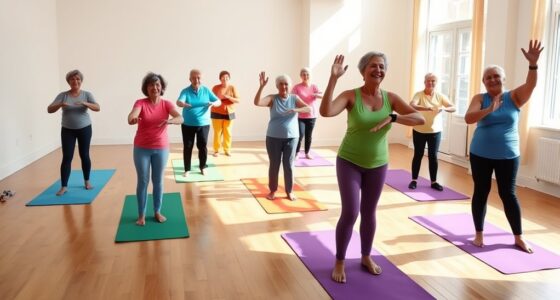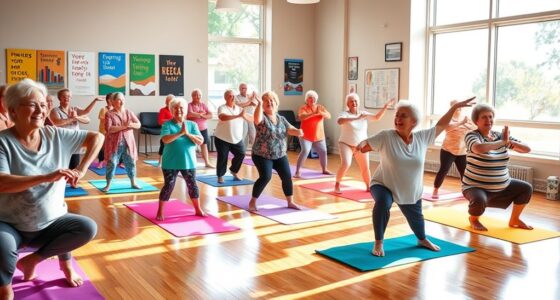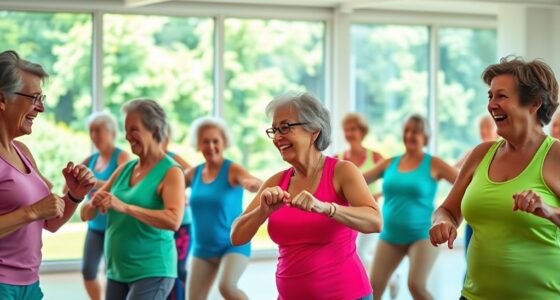To feel stronger every day, shift your mindset towards longevity and functional fitness. Use dumbbells for their versatility and effectiveness in targeting specific muscle groups. Incorporate total-body movements like squats and deadlifts for balanced strength. Prioritize recovery techniques, like gentle stretching and foam rolling, to enhance performance and prevent injury. Don’t overlook smaller exercises that maintain strength and stability. As you explore these strategies, you’ll discover even more ways to enhance your fitness journey.
Key Takeaways
- Focus on total-body movements like squats and deadlifts to enhance overall strength and functional fitness.
- Incorporate safe movement practices, such as Romanian deadlifts and floor presses, to prevent injuries.
- Utilize dumbbells for flexibility and isolation exercises, catering to individual strength needs.
- Implement recovery techniques like foam rolling and gentle stretching to improve flexibility and reduce stiffness.
- Celebrate small achievements to foster sustainable habits and motivate ongoing engagement in fitness activities.
Change Your Mindset
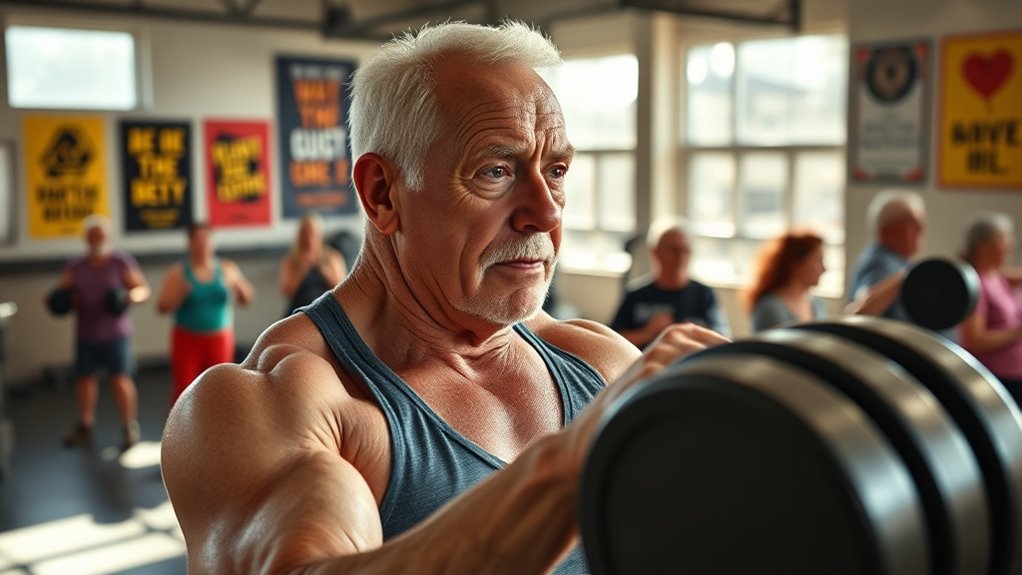
As you age, it’s essential to shift your mindset about fitness to prioritize longevity and functional strength. Instead of trying to replicate high-intensity workouts from your 20s, focus on smart training that emphasizes form and technique. Incorporating retirement planning strategies into your overall wellness approach can also provide a holistic benefit to your lifestyle. This approach not only helps you build strength but also protects your mental health by reducing the risk of injury and burnout. Embracing a long-term perspective on fitness encourages sustainable habits, so celebrate small achievements along the way. Additionally, engaging in community or group activities can provide support and motivation as you embark on your fitness journey.
By adopting a growth mindset, you can better adapt to the changes that come with aging and remain committed to your fitness goals.
Set realistic goals that motivate you, and remember that adequate attention to sleep, stress management, and nutrition greatly enhances your training capacity.
Dumbbells Are Your Friend

[Dumbbells can be a game changer for your workouts, offering both comfort and flexibility that traditional barbells just can’t match. They allow you to perform isolation exercises, helping you recover and target specific muscle groups effectively. Plus, with adjustable weights, you can tailor your routine to fit your needs and abilities. Additionally, incorporating strength training techniques can further enhance your overall fitness and strength. Regular puppy training classes can also be beneficial for building discipline and consistency, which are important not just for dogs but can translate to our own workout routines. Including a balanced breakfast, such as Egg Rollup and Dumpling Sauce, can provide the necessary energy to power through your workouts. Remember to prioritize balanced nutrition to support your physical activity and overall health.
Comfort and Flexibility Benefits
When you’re looking to create a comfortable and flexible workout routine, incorporating dumbbells can be a game-changer. They offer a tailored experience that caters to your individual needs, making strength training safer and more effective.
With dumbbells, you can enjoy:
- A wider range of movements that accommodate your strength levels
- Improved form during exercises, reducing the risk of injury
- Enhanced total-body workouts that boost your functional fitness
- Advanced filtration systems in home workout areas can help capture allergens, making your environment healthier. Furthermore, using essential oils for toothache relief can aid in managing any discomfort that may arise from physical activities. Additionally, engaging in interactive learning toys can help stimulate cognitive growth, just as strength training supports physical development. Using hydrocolloid patches during recovery can also assist in treating any skin issues that arise from physical activities. Additionally, incorporating freshly squeezed juices into your diet can provide essential nutrients to support your energy levels during workouts.
Isolation Exercises for Recovery
While many workouts focus on compound movements, isolation exercises with dumbbells can play an essential role in your recovery. These exercises allow you to target specific muscle groups, leading to quicker recovery times than compound movements that stress multiple muscles. By incorporating bodybuilding-style isolation exercises, you’ll maintain muscle mass and combat sarcopenia, helping you feel stronger as you age. Engaging in self-care routines can also support your physical recovery by ensuring you replenish your energy levels. Additionally, fueling your body with antioxidant-rich foods can enhance muscle recovery and overall health, making it beneficial to include fiber-rich foods in your diet to support satiety and weight management. Including chia seeds in your meals is a great way to boost your fiber intake while enjoying their nutritional benefits. Dumbbell exercises like bicep curls and tricep extensions can be easily modified to suit your strength levels, making them accessible at any fitness stage. Regularly performing these exercises not only enhances your strength but also improves balance and coordination, which are vital for minimizing injury risk. Additionally, strong communication skills can enhance your motivation and connection with fitness communities, further supporting your recovery journey. Embrace isolation exercises to support your recovery journey!
Embrace Bodybuilding Moves

To boost your strength as you age, incorporating bodybuilding moves is key. Isolation exercises like bicep curls help target specific muscles, while total-body movements enhance your overall fitness. Engaging in ethical hacking can also be seen as a metaphor for strengthening your defenses, just like building muscle helps protect your body. Additionally, understanding the IRA investment strategy can provide a foundation for securing your financial future as you prioritize your health. A diet rich in raw fruits and vegetables can provide nutrient retention that supports your strength training efforts. Including seeds such as chia for their omega-3 content can further enhance your diet and recovery. Don’t forget to emphasize recovery techniques to keep your body in top shape for your workouts. Incorporating a balanced diet, including low-carb meal options, can further support your strength training efforts.
Importance of Isolation Exercises
Isolation exercises play an essential role in any older man’s fitness routine, especially when it comes to targeting specific muscle groups. By incorporating these movements, you can effectively enhance your overall health and maintain functional strength. Additionally, utilizing automation’s role in tracking your progress can provide valuable insights into your workout effectiveness. Many older adults find that engaging in cultural festivals within their communities can also motivate them to stay active.
Consider adding exercises like:
- Bicep curls for stronger arms
- Tricep extensions to improve upper body stability
- Lateral raises for better shoulder control
These bodybuilding-style isolation exercises allow you to use lighter weights, making them safer and more comfortable. They promote muscle hypertrophy and quicker recovery times, reducing soreness. Most importantly, focusing on these smaller movements helps combat age-related muscle loss, ensuring you stay strong and injury-free as you age. Embrace isolation exercises to feel more empowered in your daily activities! Additionally, it’s crucial to understand that environmental interactions can significantly influence your overall fitness journey and motivation. Regularly engaging in required minimum distributions from your retirement savings can provide the financial stability needed to maintain your fitness regimen without stress.
Total-Body Movement Benefits
Incorporating total-body movements into your workout routine can greatly enhance your overall strength and functional fitness. Exercises like squats and deadlifts engage multiple muscle groups at once, helping you build muscle and achieve better coordination and balance. Additionally, understanding survival skills can contribute to your physical preparedness, ensuring you remain agile and ready for any situation.
These benefits are essential for preventing falls and injuries as you age. Additionally, consistently performing total-body movements can boost your metabolic rate, making weight management easier and supporting your overall health. Emergency preparedness also emphasizes the importance of maintaining physical fitness to ensure you can react swiftly in times of crisis.
Embracing a variety of these exercises not only makes your workouts more enjoyable but also encourages long-term adherence to your fitness regimen. By focusing on total-body movements, you’ll create a sustainable routine that empowers you to feel stronger and more capable every day.
Emphasizing Recovery Techniques
While you might think that intense workouts are the key to progress, emphasizing recovery techniques through bodybuilding moves can actually be more beneficial for older men.
Incorporating these techniques will help you enhance your range of motion and promote overall performance without excessive fatigue.
Consider adding these recovery techniques to your routine:
- Foam rolling to alleviate muscle tightness and improve elasticity.
- Gentle stretching to enhance flexibility and reduce stiffness after workouts.
- Total-body isolation exercises to boost recovery while minimizing injury risk.
Work Hard, Recover Harder

To build strength and endurance, older men must prioritize recovery just as much as the workouts themselves. Allowing extended recovery times post-workouts is key; consider incorporating foam rolling to enhance muscle recuperation and prevent injuries.
Limiting training sessions helps you avoid overexertion, maintaining your energy levels while promoting better recovery between workouts. Focus on moderate bodybuilding-style isolation exercises, which can lead to quicker recovery without excessive strain.
Build Power

Recovery is essential, but building power is equally important for older men looking to maintain muscle health.
Power training combats sarcopenia and helps you stay strong and active. Engaging in quick lifts with lighter weights twice a week can keep you healthy and enhance your explosiveness.
Consider incorporating these exercises into your routine:
- Kettlebell swings for dynamic strength
- Medicine ball throws to boost coordination
- Plyometric jumps for explosive power
These movements not only build muscle but also improve balance and mobility, critical for preventing falls.
Remember, a protein intake of 35-40 grams per meal is key after your workouts for muscle repair.
Regular power training guarantees you maintain strength and vitality as you age.
Importance of Smaller Exercises
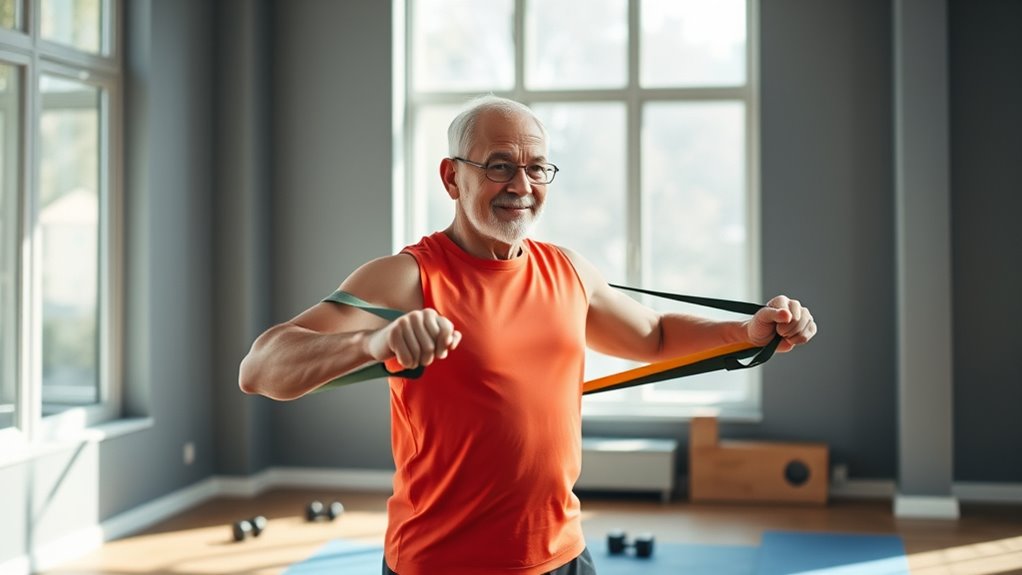
As you age, incorporating smaller exercises into your routine becomes vital for maintaining strength and mobility. These targeted workouts can greatly enhance your functional strength and balance, essential for preserving independence. For instance, elevated hip bridge holds strengthen hamstrings and improve core stability, while the Pallof press engages your core, supporting spinal health. Resistance band pull-aparts boost midback strength, promoting shoulder health. Regularly adding these exercises can lead to considerable improvements in your overall performance and reduce injury risk.
| Exercise | Benefits |
|---|---|
| Elevated Hip Bridge Holds | Strengthens hamstrings, enhances core stability |
| Pallof Press | Supports spinal health, alleviates back pain |
| Resistance Band Pull-Aparts | Improves midback strength, reduces shoulder injuries |
| Core Engagement Exercises | Bolsters balance, promotes functional strength |
| Flexibility Routines | Enhances mobility, prevents stiffness |
Safe Movement Practices
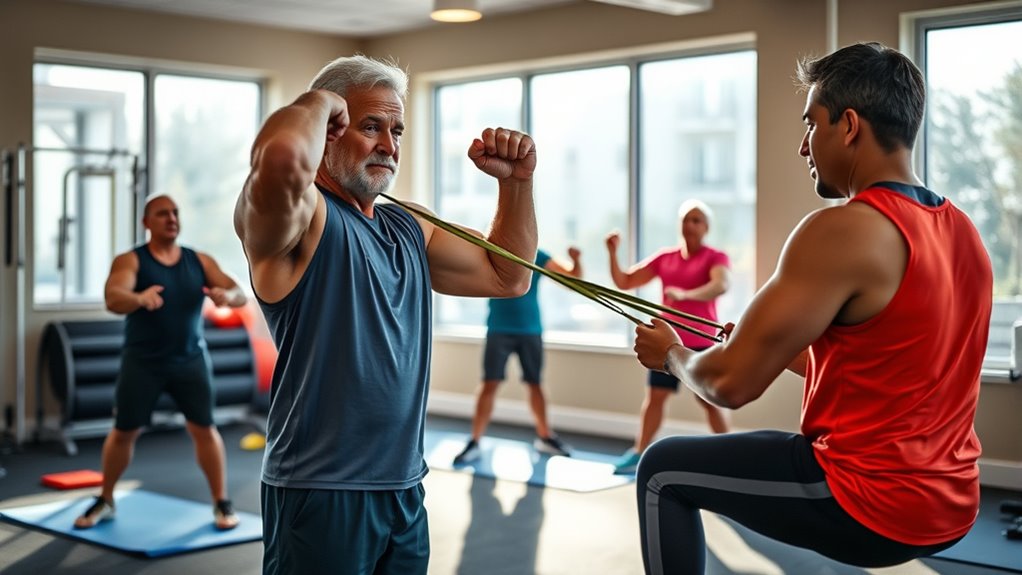
While engaging in physical activity, prioritizing safe movement practices is essential for older men looking to maintain their strength and prevent injuries.
Focusing on foundational strength helps you build muscle effectively. Consider these safe movements:
- Romanian deadlifts: A safer option for those with limited hip mobility, ensuring proper form.
- Floor presses: Protect your shoulder joints while developing chest strength, keeping your weights around shoulder height.
- Hollow holds: Strengthen your core to promote stability and balance without injury risks.
Strengthening and Balance Exercises

To stay strong and balanced as you age, incorporating a mix of strengthening and balance exercises into your routine is essential.
Strengthening exercises like wall pushups and pelvic tilts help prevent muscle and bone mass loss, particularly important for older men facing osteoporosis. Don’t forget about lower leg strengthening exercises, such as calf raises and ankle rotations, which can enhance your mobility and leg strength.
Balance exercises, including tai chi and single-leg routines, boost stability and reduce the risk of falls.
Simple moves like abdominal contractions and shoulder blade squeezes can be done at home, maintaining your core stability and upper body strength.
Stretching Routine
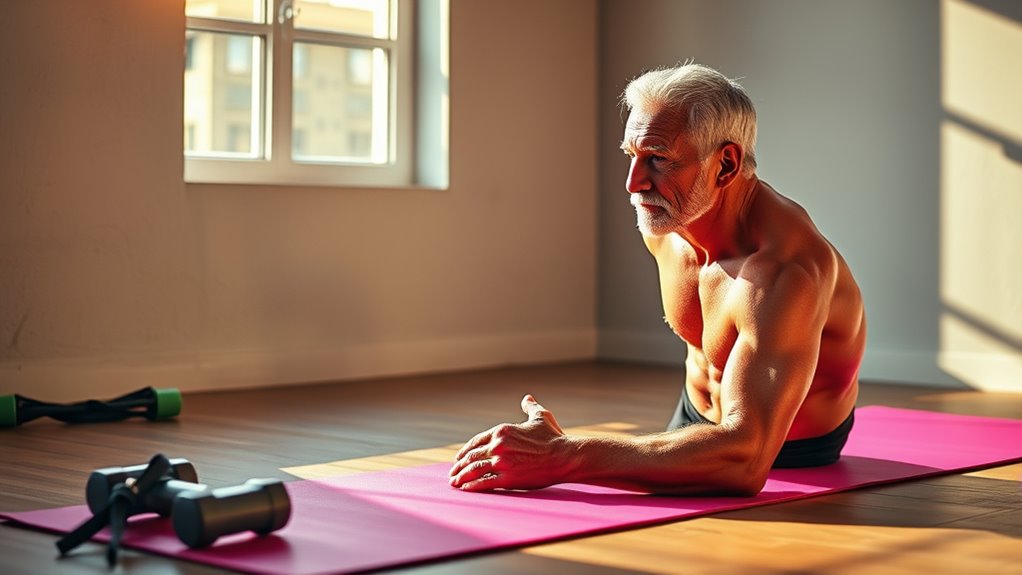
A regular stretching routine is essential for older men looking to enhance flexibility and ease in daily activities. By holding stretches for 10 to 30 seconds and repeating them 3 to 5 times, you can greatly improve your range of motion while reducing muscle stiffness.
Incorporate stretches targeting major muscle groups to promote overall well-being:
- Neck stretches to alleviate tension and improve posture.
- Upper back stretches to relax tight shoulder blades and enhance mobility.
- Leg stretches for increased flexibility and injury prevention.
Daily stretching not only helps with discomfort but also contributes to better joint mobility and muscle elasticity.
Make stretching a part of your routine, and you’ll feel stronger and more agile every day.
Frequently Asked Questions
What Is the Best Strength Exercise for a 70 Year Old Man?
When considering the best strength exercise for a 70-year-old man, bodyweight squats stand out. They build lower body strength and improve balance without the risks associated with heavier weights.
You can also incorporate resistance band exercises, which provide a safe way to strengthen muscles gradually.
Don’t forget about dumbbell exercises like seated shoulder presses, and functional movements like step-ups. These will enhance your mobility and overall strength, helping you stay active and independent.
What Is the 6 12 25 Rule?
The 6 12 25 Rule is a simple yet effective workout guideline. You perform 6 exercises, doing 12 repetitions of each, using 25% of your one-repetition maximum weight.
This approach helps you build strength and endurance while minimizing injury risk. It promotes a balanced training routine that combines strength and stability, making it easier for you to stay consistent and achieve long-term fitness goals.
Can a 70 Year Old Man Still Build Muscle?
Can a 70-year-old man still build muscle? Absolutely!
You can increase your muscle mass and strength, even into your 80s and 90s, with consistent resistance training. Engaging in power training with lighter weights a couple of times a week can effectively counteract age-related muscle loss.
Just remember to focus on adequate protein intake—aim for about 35-40 grams per meal—and incorporate total-body exercises to enhance your strength and recovery.
How Often Should a 60 Year Old Man Strength Train?
If you’re 60 years old, you should aim to strength train at least 2 to 3 times a week.
This frequency helps maintain muscle mass and fight age-related loss. Each session should include a mix of exercises targeting major muscle groups, focusing on total-body movements.
Start with lighter weights and gradually increase intensity. Don’t forget to allow 48 hours of recovery for the same muscles to promote repair and prevent injury.
Conclusion
So, if you think you can just lounge around and wait for strength to magically appear, think again! Embrace those dumbbells like they’re your long-lost friends, tackle bodybuilding moves, and remember: recovery isn’t just a nap—it’s an art form. You’re not just building muscle; you’re crafting a masterpiece of power and balance. So, dust off that yoga mat and stretch it out like you’re preparing for an Olympic event. Who knew feeling stronger could be this entertaining?


